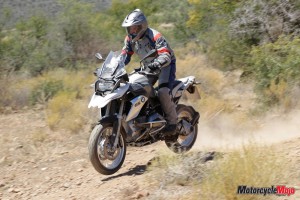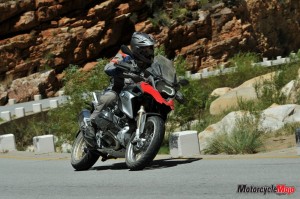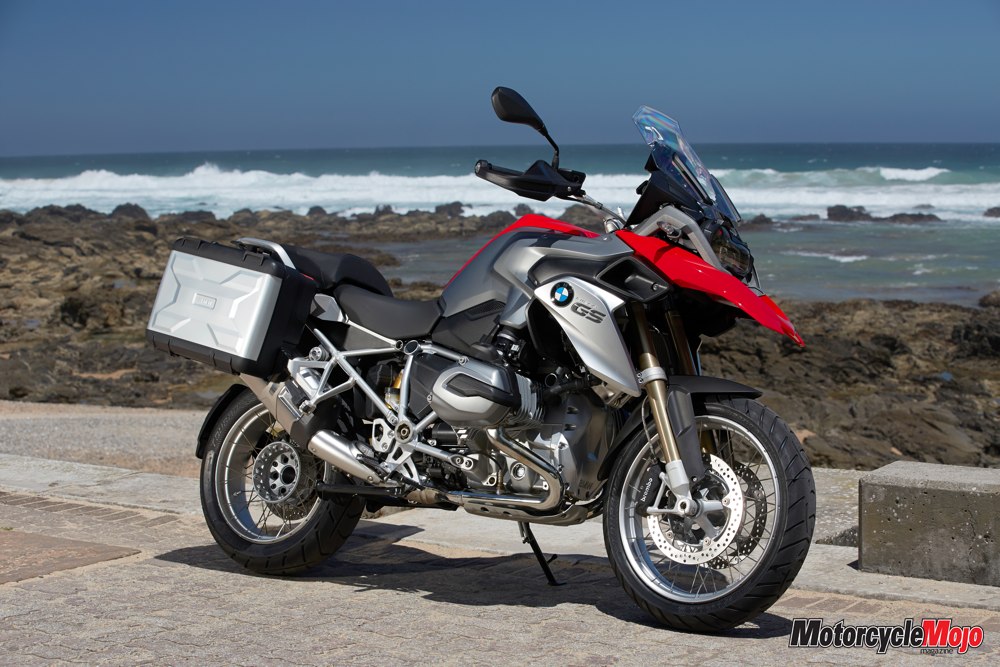A driveline design that stems back 90 years gets a major overhaul, and the 32-year-old icon of world motorcycle travel gets a few sweeping changes as well.
BMW’s 2013 R1200GS traces its roots to a machine that spawned the adventure-touring category. The R80G/S, ancestor of the R1200GS, was introduced in late 1980 as a 1981 model. That machine was inspired by a long-distance desert race that was then in its infancy: the Paris-Dakar Rally.
The bike gained popularity over the years, and gradually grew in displacement from its original 798 cc to its current 1170 cc. The latest version receives a multitude of changes, though it maintains its recognizable profile. My chance to ride BMW’s latest and radically altered GS model came at its international press launch, held in the city of George, South Africa. We were scheduled to ride more than 500 km over the span of two days, but the inherent risks of the job were sadly revealed, however, when a colleague from the United Kingdom, moto-journalist Kevin Ash, tragically lost his life in a crash during the launch. This shortened our riding schedule for obvious reasons, though we still had the chance to ride a full day, covering about 250 km over a variety of terrain.
 BMW’s fifth-generation R1200GS doesn’t just signify a new direction for the big adventure-touring machine; it also marks a paradigm shift in the German company’s boxer-twin engine. Since its introduction in 1923, the horizontally opposed engine has seen countless changes and improvements. Despite this, a few things remained constant: Its flat cylinder layout, air cooling, a single-plate dry clutch, and a separate gearbox bolted to the rear of the crankcase, much like a car engine.
BMW’s fifth-generation R1200GS doesn’t just signify a new direction for the big adventure-touring machine; it also marks a paradigm shift in the German company’s boxer-twin engine. Since its introduction in 1923, the horizontally opposed engine has seen countless changes and improvements. Despite this, a few things remained constant: Its flat cylinder layout, air cooling, a single-plate dry clutch, and a separate gearbox bolted to the rear of the crankcase, much like a car engine.
That has all changed – well, except for the flat cylinder layout. For the first time in its 90-year history, the BMW boxer engine gets liquid cooling. It’s not regular liquid cooling; the coolant is targeted in a system BMW calls “precision cooling,” where liquid flows only to the highest heat-stressed areas in the cylinders and heads, while large cooling fins continue to dissipate most of the heat generated in the cylinders. BMW even provided a ratio of liquid and air cooling for those who keep track of such things: Coolant helps dissipate 35 percent of the heat produced in the engine, with air taking care of the remaining 65 percent. The coolant is routed to twin radiators mounted on either side of the bike, just below the steering head.
Before you even sit on the bike, if you’re a BMW aficionado, you’ll notice something else that’s different about the engine. The throttle bodies are now located at the top of the cylinder heads and the exhaust exits at the bottom. This new vertical port layout is beneficial because it frees up some space ahead of your shins when you’re seated, and it also improves airflow into the cylinders, increasing power. The new engine produces 125 hp, a 15 hp increase over the previous model, and peak torque is also up to 92.2 ft-lb from 88.
 Look deeper, and you’ll notice another first for the boxer-twin: The gearbox is no longer a separate component. It used to be bolted behind the engine, but is now integrated into the crankcase, with the gear cluster located beneath the crankshaft. This has shortened the engine considerably, allowing engineers to lengthen the swingarm by 53 mm without altering the wheelbase, thus improving traction as well as rear suspension compliance. It has also lowered the centre of gravity, for better handling.
Look deeper, and you’ll notice another first for the boxer-twin: The gearbox is no longer a separate component. It used to be bolted behind the engine, but is now integrated into the crankcase, with the gear cluster located beneath the crankshaft. This has shortened the engine considerably, allowing engineers to lengthen the swingarm by 53 mm without altering the wheelbase, thus improving traction as well as rear suspension compliance. It has also lowered the centre of gravity, for better handling.
We leave the hotel in George in South Africa’s early morning heat, with temperatures already in the high 20s. We’re to head north into the mountains, though the elevation will offer no break from the heat, as the area forecast calls for highs in the low 40s. Our route will take us along a combination of winding paved and dirt roads.
After starting the new GS, I’m greeted by the characteristic drone of a boxer engine, though the bike has a raspier exhaust note, higher in pitch than the outgoing model. The engine also spins up much quicker when blipping the throttle, a result of the smaller-diameter clutch, but also because of a new, lighter crankshaft. This also reduces, almost to nil, the tendency of the bike to lurch to the right when blipping the throttle at a stop.
Seat height is adjustable to two positions (850 and 870 mm), but it can also be adjusted for tilt depending on how you position the underseat mounts. If you have a shorter inseam (I’m six feet tall), a low seat (820–840 mm) is optional at no cost. I set the standard seat higher by flipping both the front and rear mounts into their higher positions. Flipping only the rear mount tilts the seat forward. There’s no storage space under the seat except maybe for paperwork, and you’ll also find the Enduro Pro plug under there (more on that later).
Once rolling, the new bike has that unmistakable GS feel. If you’ve ridden one, you know what I mean. It’s solid, planted, refined and smooth. But it also feels quite different. There’s a new, more pronounced intake howl when accelerating. The airbox is now located directly above the engine and ahead of the mid-mounted, 20-litre fuel tank, with twin intakes mounted higher than before and to either side of the steering head. Aside from the increased intake honk, this also reduces the likelihood that the engine will drown out in deep-water crossings. Also, despite a 9 kg heavier claimed curb weight over the old bike (it’s now at 238 kg), the new GS actually feels lighter, whether you’re moving or at a stop. This is due to the lower centre of gravity, but also because the bike has a narrower midsection.
A new frame is now a one-piece unit from which the engine hangs, whereas the former bike had a forward and rear portion with the engine mounted in the middle. The frame is still made of tubular steel, and a bolt-on tubular steel sub-frame supports the seat and tail section. Steering geometry is almost identical, with some minute changes in the rake and trail measurements.
Standard suspension uses a non-adjustable fork and rear shock adjustable for rebound damping and preload, but among the GS’s most convenient features, available on bikes equipped with the optional Dynamic ESA (electronic suspension adjustment), are the ride modes. There are five – Rain, Road, Dynamic, Enduro and Enduro Pro – and they adjust throttle response, Enduro ASC levels (traction control), ABS and suspension settings to match the riding conditions. Suspension settings vary from ultra-plush in Enduro mode to almost racetrack firm in Dynamic mode. Traction-control intervention also varies among the modes, as does ABS effectiveness.
Individual modes can also be custom tailored; if you prefer a firmer suspension setting in Enduro mode, you can change it while riding via a handlebar-mounted switch, and the modes can also be changed on the fly, though you have to shut the throttle and pull the clutch to confirm your selection. I sampled them all, even the Rain mode – despite the hot, dry weather – and they are all effective. None of the modes limit maximum power, but throttle response is greatly altered. It is softened in Rain and Enduro modes, normal in Road mode, and more aggressive in Dynamic and Enduro Pro modes.
When we turn onto a dirt road, without stopping, I switch from Road to Enduro mode and feel the difference almost immediately. Throttle response is instantly softened, and the suspension goes from firm to very soft in a matter of seconds.
The latest ABS is a vast improvement over the old system. It used to be preferable to shut the ABS off when wandering off-road; otherwise, loose conditions would trip it and stretch braking distances considerably. This is no longer the case. The new ABS works flawlessly in Enduro mode, slowing the bike effectively without fear of lock-up or overshooting corners, and if you still don’t feel confident in its efficiency, you can turn it off. You can also shut off the traction control. Surprisingly, the stock Metzeler Tourance Next tires grip with remarkable tenacity on dirt roads, despite their lack of knobbies.
BMW set up a short, rough, off-road circuit, and I swap my stock test bike for one equipped with more aggressive, Metzeler Karoo 3 tires. The bike also has a taller, one-piece off-road saddle, and I select Enduro Pro mode, which has firmer suspension and more aggressive throttle settings than Enduro mode. Enduro Pro mode can only be selected after a plug, provided with the bike, is inserted into a socket located under the seat. It’s ideal if you want to blast, high-speed, through rough sections, but at the moderate pace I settle upon, Enduro mode would have been just fine. Regardless, I swallow up a steep, rocky climb without even thinking about it. Although it’s no dirt bike, the R1200GS can still manage rough conditions with relative ease, as long as you don’t try bouncing off berms or landing doubles.
Throttle response is just a tad too abrupt in Enduro-Pro mode, though the suspension feels quite compliant, providing better control over the rough terrain than the softer Enduro setting. Only in Enduro Pro does the rear brake pedal work independently from the front, and it overrides the ABS when it is applied, so the rear wheel can be locked for control in tighter sections. Enduro Pro mode also remembers settings – like if the ABS or traction control is turned off – if the ignition is turned off and on again. In the other four settings, the bike resorts to its default settings any time the ignition is turned on.
Back on the road and on the standard bike, I set the mode to Dynamic for a stretch of twisties. It’s surprising how widely adjustable the suspension is, and in this mode, it’s firm enough to make the bike hop off larger bumps. However, it does settle the machine for a modestly quick pace through the winding mountain roads north of George, and the bike rails through sweepers weave-free. It also feels quicker in tight turning transitions than the old bike, no doubt a benefit of the lower centre of gravity.
The additional power has transformed the GS into a fire breather. It pulls hard right to redline, with strong bottom-end grunt getting progressively livelier as the revs pick up. The clutch, now a multi-plate unit with slipper and mechanical assist functions (the latter increases clamping power when on the gas), is light and the gearbox is among the lightest I’ve ever sampled. It’s almost too light, and with heavy off-road boots on, it’s sometimes difficult to feel the detent when shifting up or down.
The only hiccup in the bike’s handling is a possible tendency to shake its head as you stand on the foot pegs over rough terrain. On a couple of occasions while standing, I hit a succession of sharp bumps that caused the fork to shake just a bit. It isn’t alarming, it’s just that I don’t remember the old bike having any tendency to do this. A longer test ride will be needed to confirm if this was just an anomaly.
Heated grips and ABS are standard, and there are a few options that can be added individually, like cruise control ($400), a tire-pressure monitor ($225) and spoke wheels ($450), among other items. There are also four options packages available. The Comfort package includes the tire-pressure monitor, luggage brackets and hand guards for $625. The Touring package adds to that Dynamic ESA, GPS hardware (without GPS), an onboard computer and chromed exhaust for $1,600. The Active package includes Enduro ASC (traction control) and cruise control for $800, and the Dynamic package includes ASC, ESA, GPS hardware, computer and the LED headlight for $2,300. All of the test bikes at the South African launch were equipped with BMW’s optional and exclusive LED headlights, but a late-day sunset meant we didn’t get to see how effective they can be.
The 2013 R1200GS has set a new standard in adventure touring. It is the benchmark by which all other adventure bikes are measured, and the bar has just been raised. Sure, some bikes might excel in certain aspects of the genre; KTMs have better off-road capability, for example. Some hardcore adventurers might scorn BMW for making it more difficult to service certain components. While the clutch, now located at the front of the engine, is a breeze to access, the alternator, now at the rear, is not so easy to work on. Neither is the transmission, which is now inside the crankcase, and servicing the cylinders or pistons is harder, as the cylinders are now cast into the vertically split crankcase.
But few adventure bikes are as well balanced as the R1200GS, and none have the pedigree. Despite the adventure-seeking capability of the GS, few riders will take one off-road. For those riders, the GS will continue to provide the unmatched road manners for which it has become renowned. For the few who actually do seek adventure, the new R1200GS will deliver in a heartbeat.
| The BASICS | |
| LIST PRICE | $18,850 |
| WARRANTY | 3 years, unlimited mileage |
| COMPANY URL | www.bmw-motorrad.ca |
| The drivetrain | |
| ENGINE TYPE | Air/liquid-cooled boxer-twin |
| DISPLACEMENT | 1170 cc |
| POWER | 92 kW (125 hp) at 7750 rpm |
| TORQUE | 125 Nm (92.2 ft-lb) at 6500 rpm |
| BORE AND STROKE | 101 x 73 mm |
| COMPRESSION RATIO | 12.5:1 |
| FUEL DELIVERY | Electronic fuel injection with 52 mm throttle bodies |
| TRANSMISSION | Six-speed |
| The essentials | |
| FINAL DRIVE TYPE | Shaft drive |
| FRONT SUSPENSION | Telelever with 37 mm stanchion tubes, non-adjustable; ESA optional |
| REAR SUSPENSION | Single shock with adjustable rebound damping and preload; ESA optional |
| WHEEL TRAVEL | Front: 190 mm (7.5 in.); Rear: 200 mm (7.9 in.) |
| BRAKES | Front: 305 mm discs with radial four-piston calipers; Rear: 276 mm disc with twin-piston caliper; linked ABS |
| WHEELBASE | 1507 mm (59.3 in.) |
| RAKE AND TRAIL | 25.5 degrees/99 mm |
| TIRES | Front: 120/70R19; Rear: 170/60R17 |
| WEIGHT (WET) | 238 kg (525 lb) |
| SEAT HEIGHT | 850/870 mm (33.5/34.25 in.) |
| FUEL CAPACITY | 20 litres |
| FUEL ECONOMY (CLAIMED) | 4.8 L/100 km hwy |
| FUEL RANGE (ESTIMATED) | 415 km |

















































